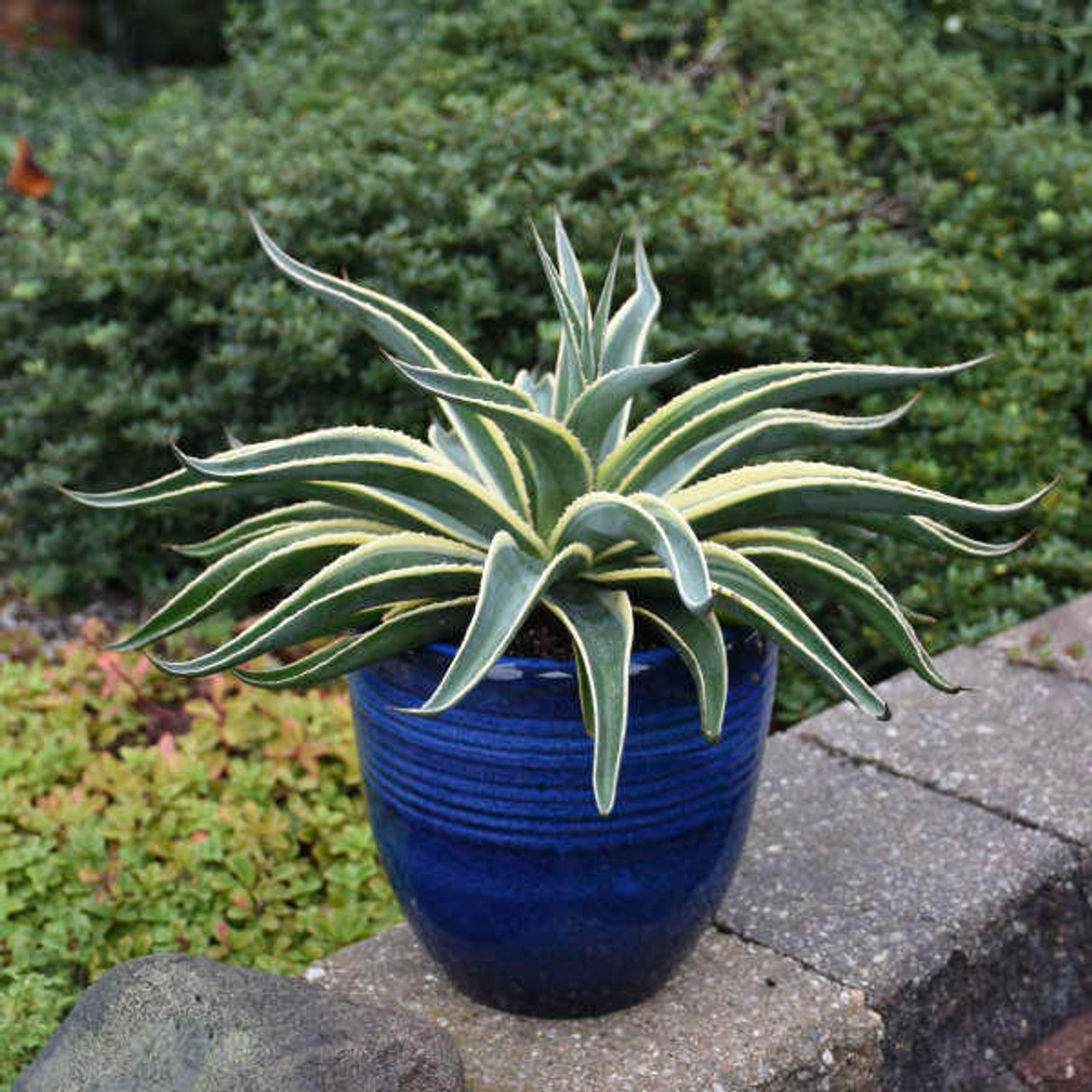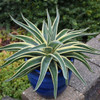Product Description
Mangave 'Navajo Princess' PP31136 - MAD ABOUT MANGAVE Collection (72)ct Flat
Common Name: Mangave
This succulent is one of our personal favorites with its clear and consistent variegation. Wide, cream margins are contrasted by deep blue-green centers. The rigid leaves form a relatively low horizontal habit that frames a container quite nicely. Minimal spotting near the crown is secondary to the bright green and cream color. Compared to 'Snow Leopard', 'Navajo Princess' have thicker, more heavily toothed leaves.
Mangave is a relatively new phenomenon, an intergeneric cross of Manfreda x Agave. These rare hybrids combine the best of both worlds: the better growth rate and the interesting patterns of Manfreda, and the habit and refinement of Agave. We are very excited (shall we say mad?) about our new hybrids from Walters Gardens hybridizing.
Mangave is a tender perennial or "temperennial" succulent plant that grows best in full sun. Plant in well-drained, dry to average soil in containers just slightly wider than the width of the rosette or plant directly in the ground. In summer when the plants are actively growing, they appreciate a bit of supplemental watering and half-strength fertilizer. They should be grown dry in winter. Mangave is a slower grower, so it will not quickly overtake the space it is allotted in the landscape.
Height: 9.0-10.0 Inches
Spread: 18.0-20.0 Inches
Hardiness Zones: 9,10,11
Foliage Color: Green shades, Variegated
Full Sun (> 6 hrs. Direct Sun)
Low Water Needs
Poor to Average Soil Quality
Deer and Rabbit Resistant
Growth Rate: Slow
Container, Drought Tolerant, Attractive Foliage, Small, Specimen, Focal Point, Native to North America
Mangave 'Navajo Princess' is a captivating succulent that results from crossing Manfreda and Agave plants. This hybrid was developed by Hans Hansen and introduced in 2018 . It is a cross between the high elevation Mexican Agave montana and the winter-hardy US native Manfreda maculosa . 'Navajo Princess' is prized for its unique foliage, hardiness, and low-maintenance requirements, making it an excellent choice for both novice and experienced gardeners.
The 'Navajo Princess' displays a stunning rosette of thick, rubbery, blue-green leaves with wide, creamy-white margins . The leaves are rigid and less prone to flopping, with larger teeth than most Mangave varieties . Minimal spotting occurs near the crown, adding subtle texture and visual interest . This cultivar reaches a height of 8 to 20 inches and spreads about 18 to 20 inches wide . The rigid leaves form a relatively low horizontal habit that frames a container nicely . One of its most notable features is the clear and consistent variegation, with wide, cream margins contrasted by deep blue-green centers .
Mangaves are a relatively new phenomenon in the world of succulents. They are a cross between Manfreda and Agave, expertly hybridized to combine the best of both parents . This gives them a similar form to a typical Agave, but with the added benefit of growing about twice as fast and being far less spiny to the touch . Unlike some Agaves, Mangaves do not perish after flowering . This makes them a more sustainable and long-lasting addition to your garden.
The 'Navajo Princess' originated in Mexico . It is an evergreen plant, meaning it retains its leaves throughout the year, providing continuous visual interest in the garden.
Care and Maintenance
- Light Mangave 'Navajo Princess' thrives in full sun and well-drained soil . For optimal growth and to bring out the best coloration, it needs at least 6 hours of direct sunlight daily . While it prefers full sun, it can tolerate more shade than most Agaves . However, be mindful of placing it in an overly sunny spot combined with low water, as this can cause the leaves to burn . If you notice the plant losing its coloring and speckles, it may not be receiving enough light .
- Soil When planting in a container, ensure it has drainage holes and use a gritty, well-draining cactus soil mix . If planting in the ground, amend the existing soil with sand, perlite, pumice, or lava rock to improve drainage .
- Water Water the plant deeply when the soil is dry, especially during the growing season . In the summer, when the plants are actively growing, they appreciate a bit of supplemental watering . Water sparingly to slow growth and reduce watering in winter when the plant is dormant . While drought-tolerant, it can tolerate more water than other succulents, provided there is excellent drainage .
- Fertilizer Fertilizing is not necessary but can encourage faster growth . Use a diluted, balanced fertilizer once a month during the growing season (spring and summer) . During the summer, you can also supplement with half-strength fertilizer . Avoid over-fertilizing, as this can lead to leggy growth .
- Repotting It is advisable to repot the Mangave every 3 years to provide new nutrients and more space for root growth . Repotting also provides the plant with fresh, airy potting soil that aids in proper watering. The best time for repotting is during the spring.
- Pests and Diseases Mangave 'Navajo Princess' is generally pest-resistant but watch for mealybugs or scale insects . Overwatering can lead to root rot, so ensure proper drainage .
- Hardiness and Uses This Mangave is hardy in USDA zones 9 to 11 and can tolerate brief periods of light frost . It thrives in temperatures between 60-75°F (15-24°C) . To overwinter in colder climates, bring the plant inside and place it in a location with as much light as possible . Keep in mind that while it might look stunning indoors year-round, it will likely lose its signature bright coloring without sufficient UV light.
Mangave 'Navajo Princess' is primarily used as an ornamental plant due to its unique appearance . It is an excellent choice for:
- Rock gardens
- Succulent gardens
- Borders
- Containers
- Xeriscaping
- Water-wise gardens
Other Considerations
- Toxicity: The sap of Mangave 'Navajo Princess' can be irritating to the skin and mucous membranes . Handle the plant with care, wearing gloves to avoid contact with the sap. It is also harmful to pets if ingested .
- Deer and Rabbit Resistance: This plant is generally resistant to deer and rabbits .
- Propagation: You can propagate 'Navajo Princess' by separating the pups that emerge from the base of the plant . Gently pull them off and replant them.
- Companion Plants: Consider pairing 'Navajo Princess' with other succulents like Stonecrop (Sedum), Blue Chalksticks (Senecio), Hens and Chicks (Sempervivum), and Echeveria (Echeveria) . These plants share similar growing requirements and can create a visually appealing and cohesive design.
Mangave 'Navajo Princess' is a striking and versatile succulent that offers a unique combination of beauty and resilience. Its distinctive variegated foliage, with creamy-white margins contrasting against blue-green centers, creates a captivating focal point in any garden setting. The plant's low-maintenance needs, drought tolerance, and hardiness make it an ideal choice for xeriscaping, container gardening, and various other landscape designs. Unlike some Agaves, 'Navajo Princess' does not die after flowering, ensuring long-lasting enjoyment in the garden. Whether you are a seasoned gardener or just starting, 'Navajo Princess' is sure to impress with its captivating presence and ease of care.
Other Details
The most important part of the plant is its root system. Healthy roots are the foundation of a healthy, vibrant plant. The type of plug container used is based on the specific needs of the plants. Perennials offered as bare root traditionally perform better when planted as bare root.Planted in a specialized mix, potted plants have well established root systems. Top growth stage will vary depending on the current life cycle and time of year when shipped. In Winter and early Spring dormant plants may be shipped. Dormant plants may be planted right away, even before the last frost date.
Most bare root varieties are field grown for at least one season, though Hemerocallis and Hosta are grown for two seasons. The bulk of the soil is removed during the harvesting process and the tops of most varieties are trimmed back to the crown. They are graded, packed in shredded aspen or sphagnum moss and stored in freezers until ready to be shipped.
See our Container Sizes and Bare Root Perennials pages for more information.
Plant information and care is provided in the Overview section, Plant Genus Page and general information is provided in the Planting Care & Guides. Additional questions can be asked on each Plant page.
Plant Spacing: Using the maximum mature spread or width of a plant to guide spacing, ensures space to grow to full size. To fill an area sooner, plant them closer together. Just remember, future thinning or transplanting may be needed.
Water: Keep a close eye on newly planted perennials, especially throughout the first growing year. Most early plant loss is due to too much or too little water!








